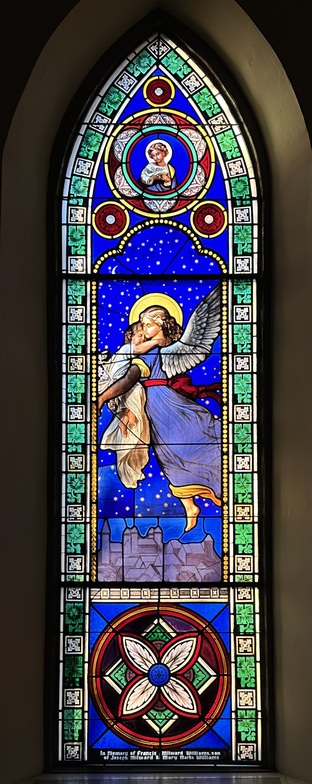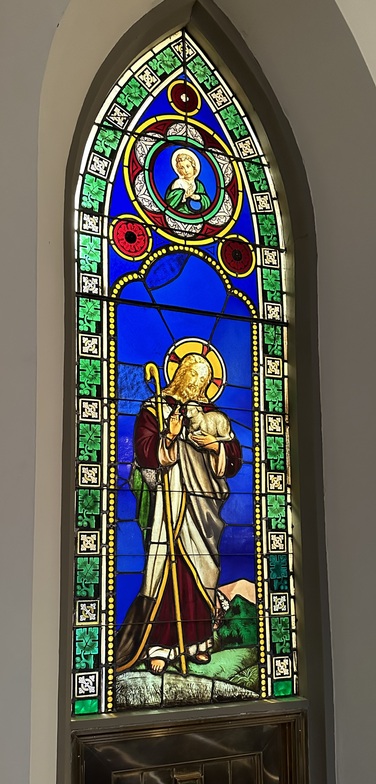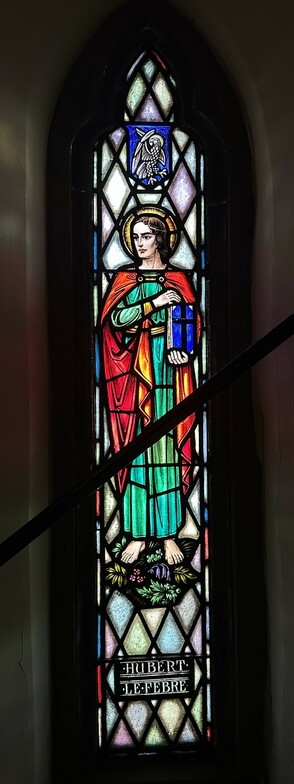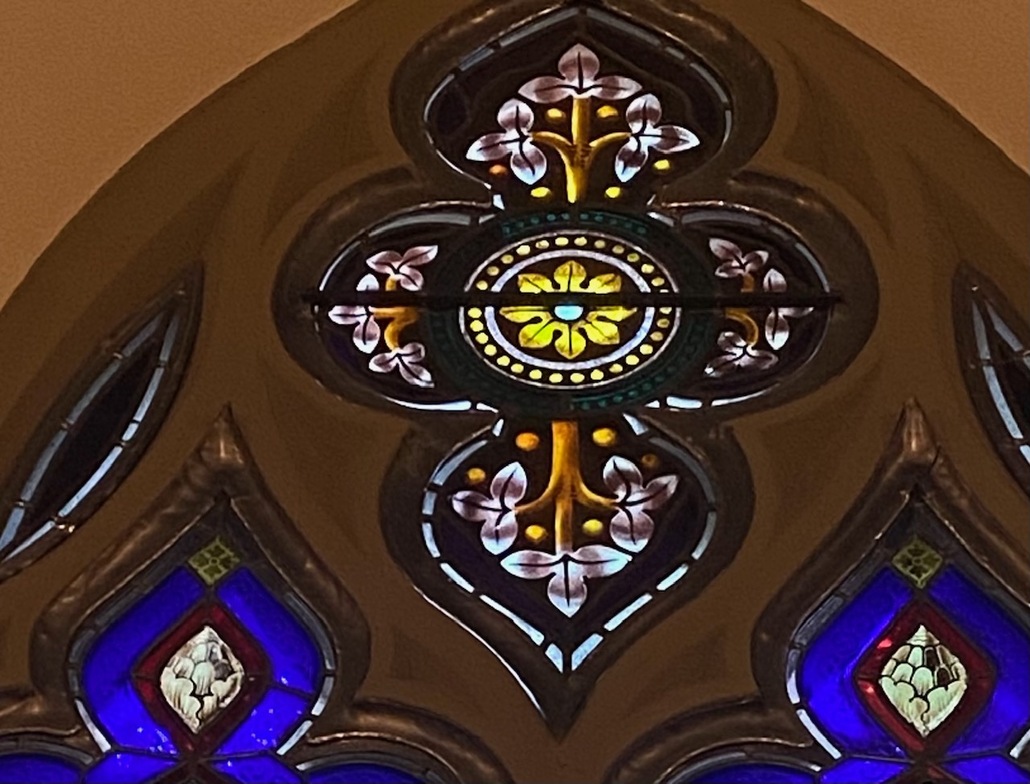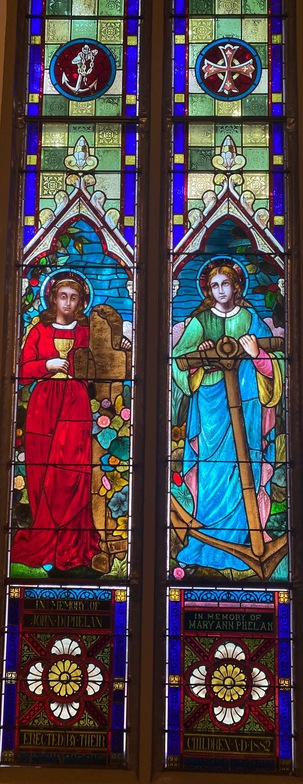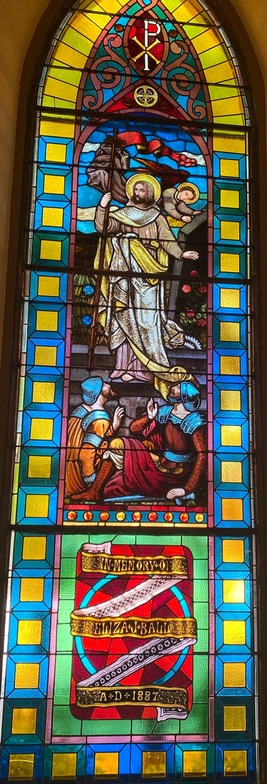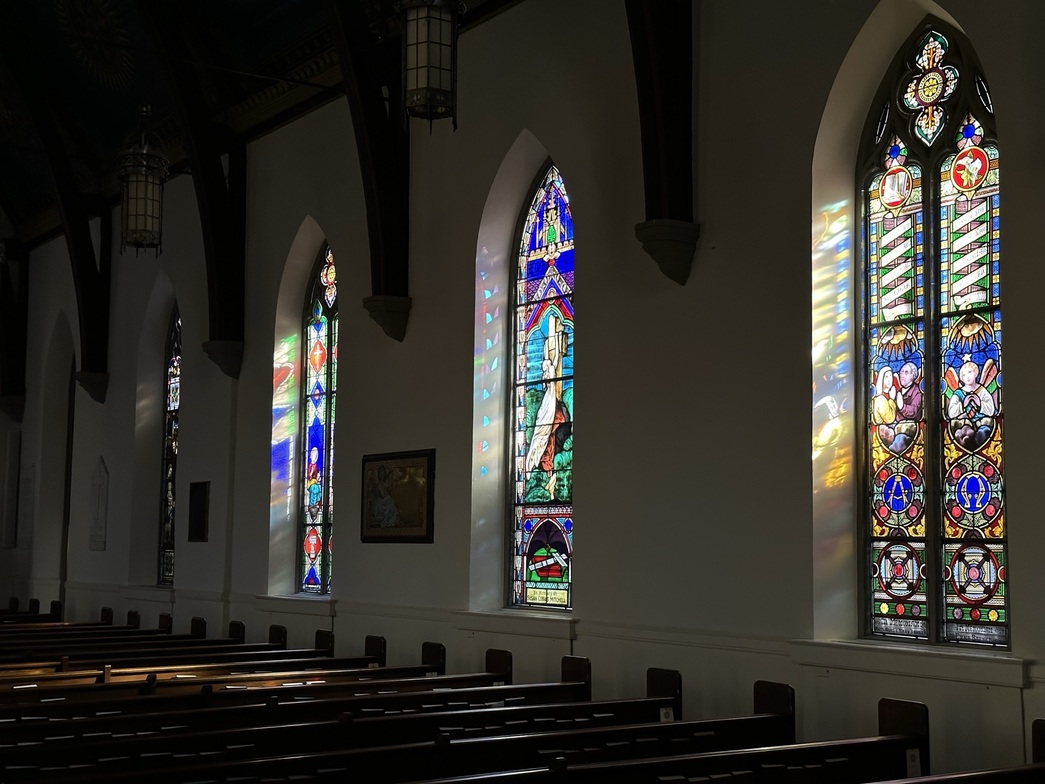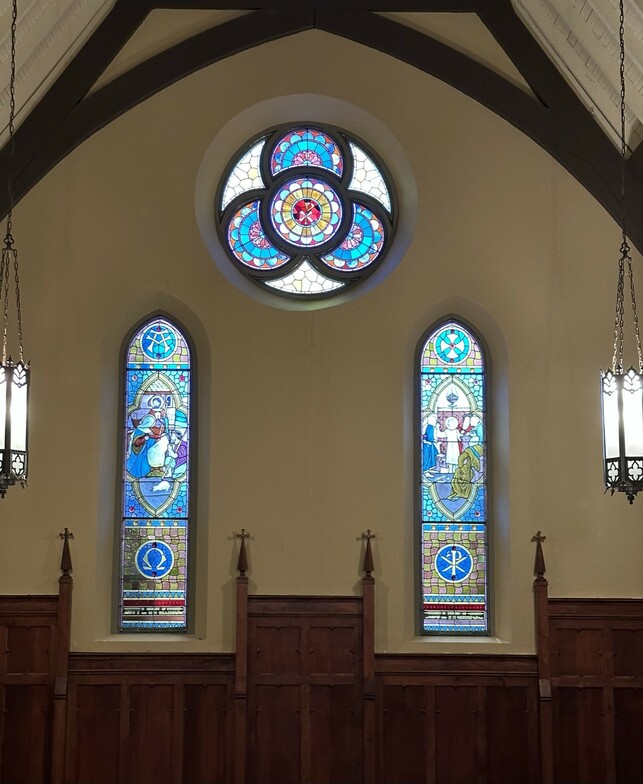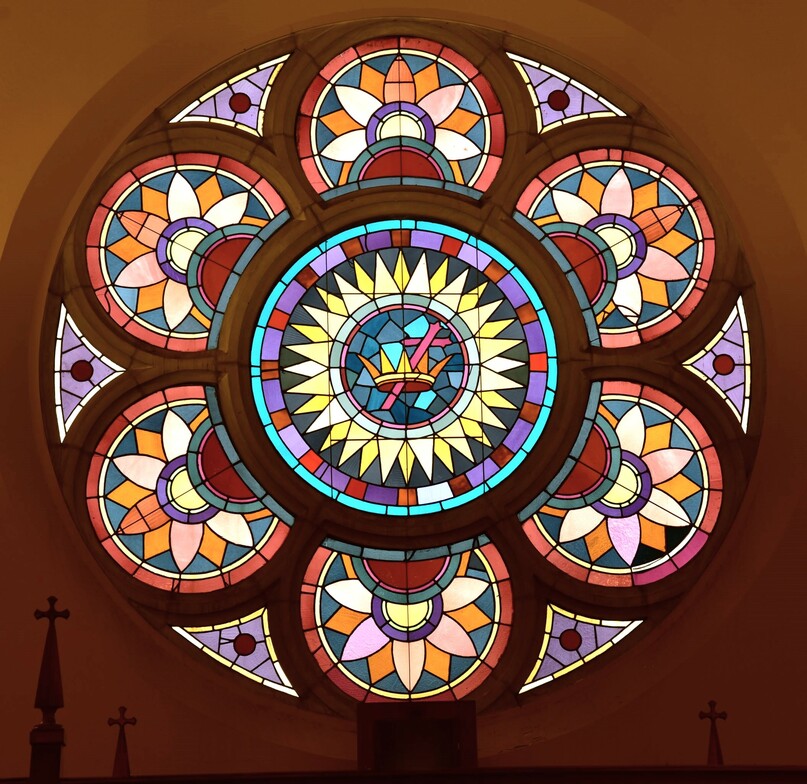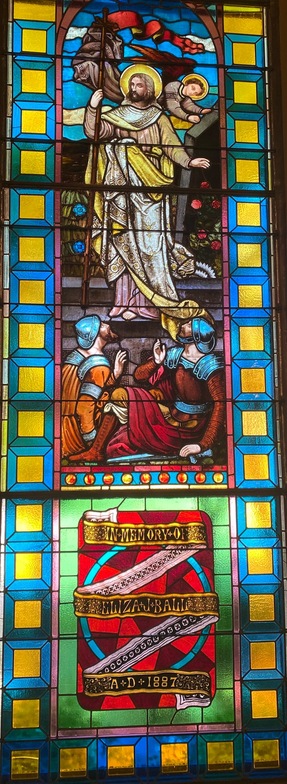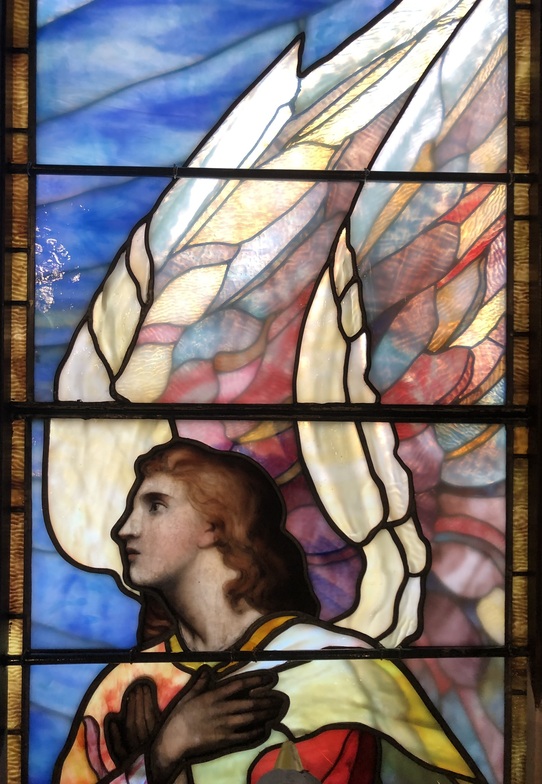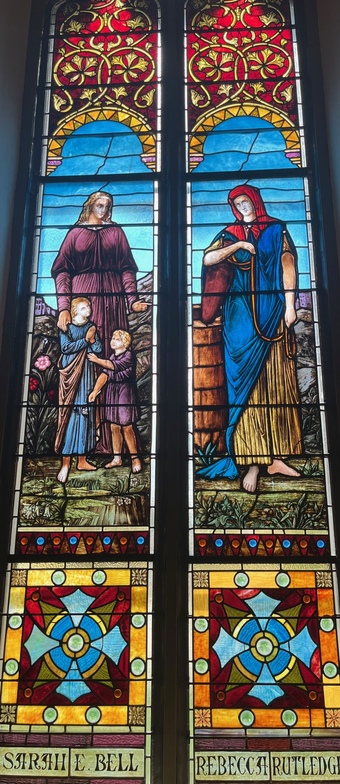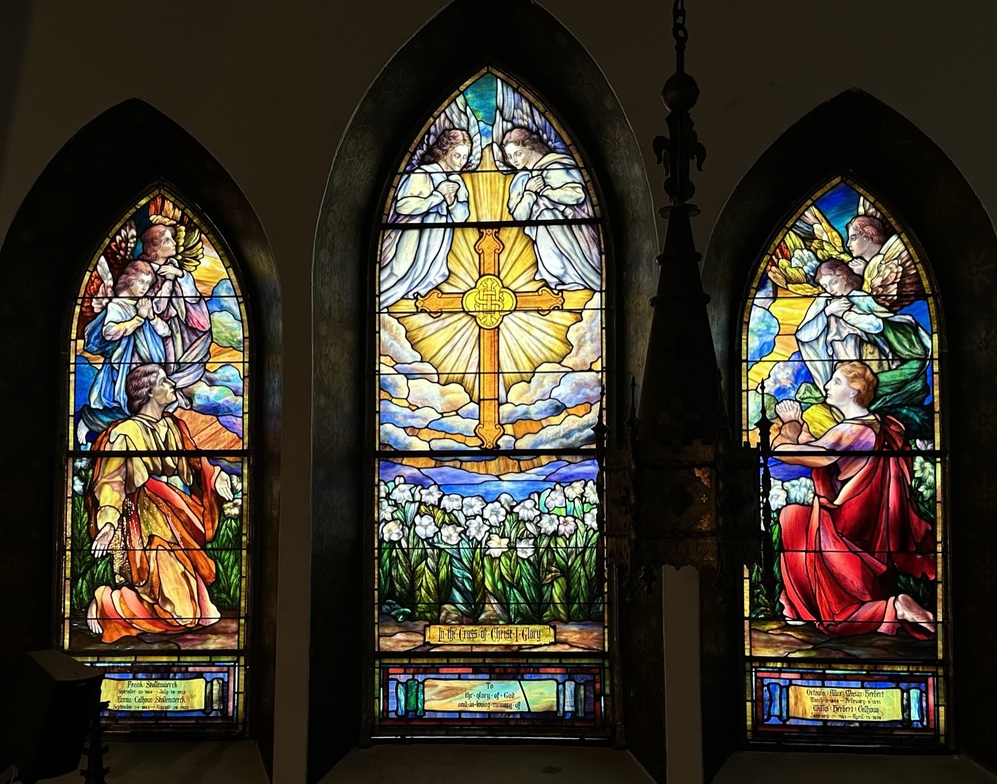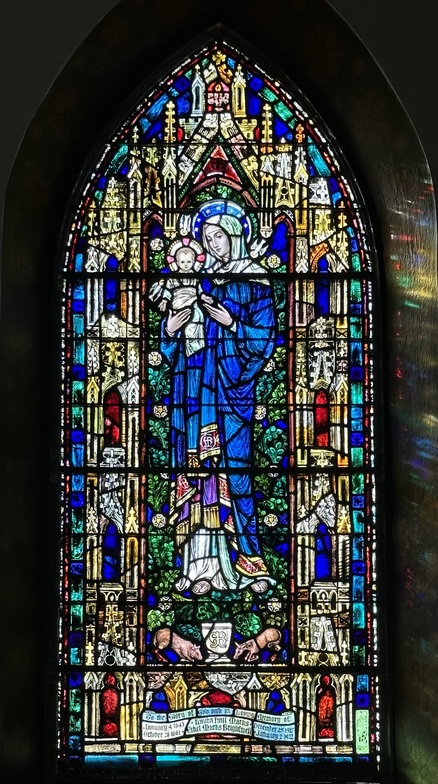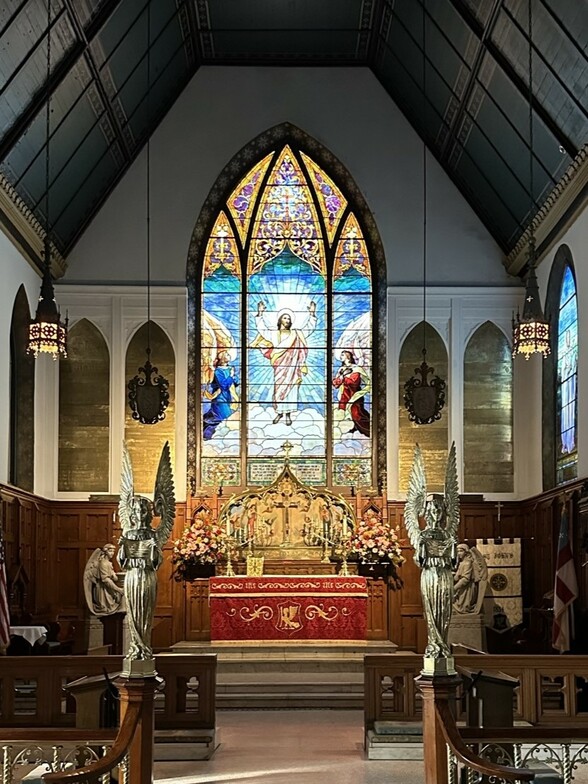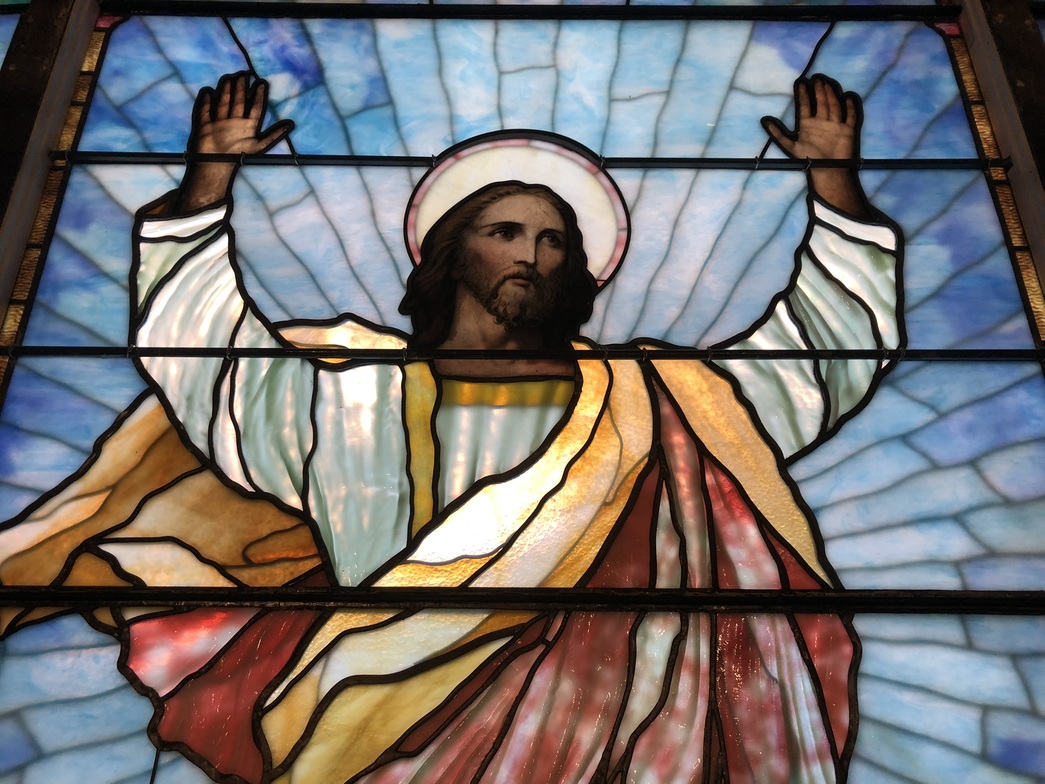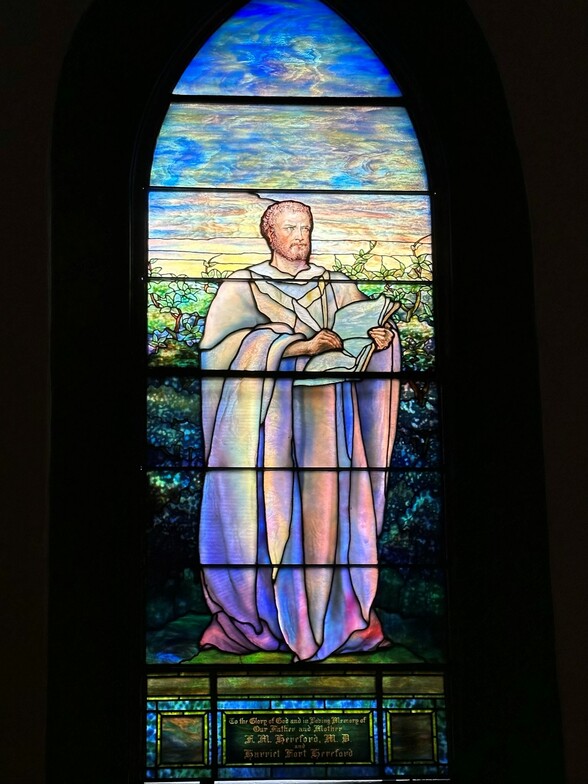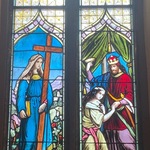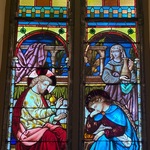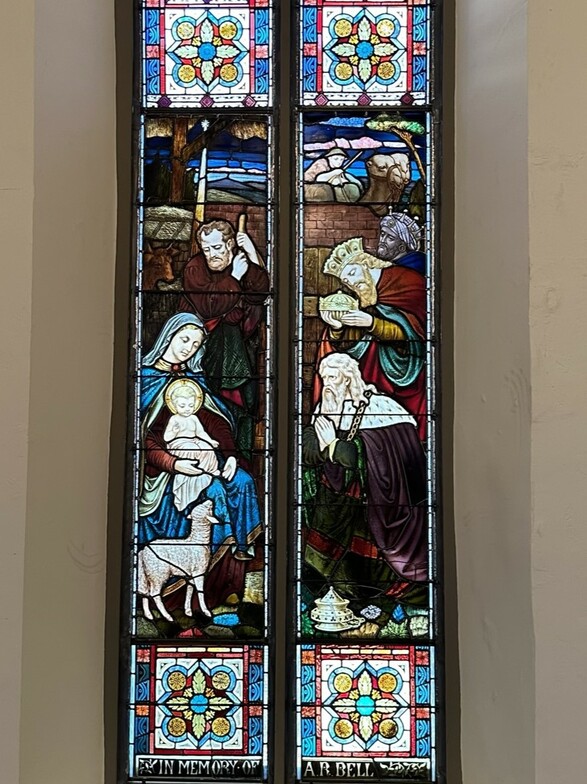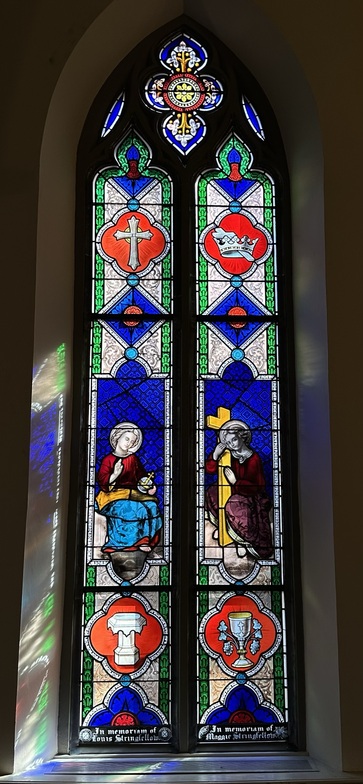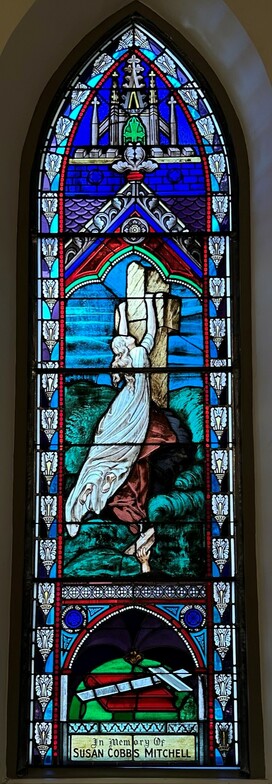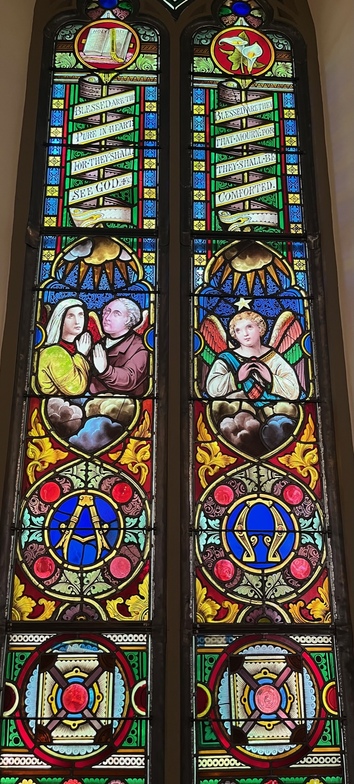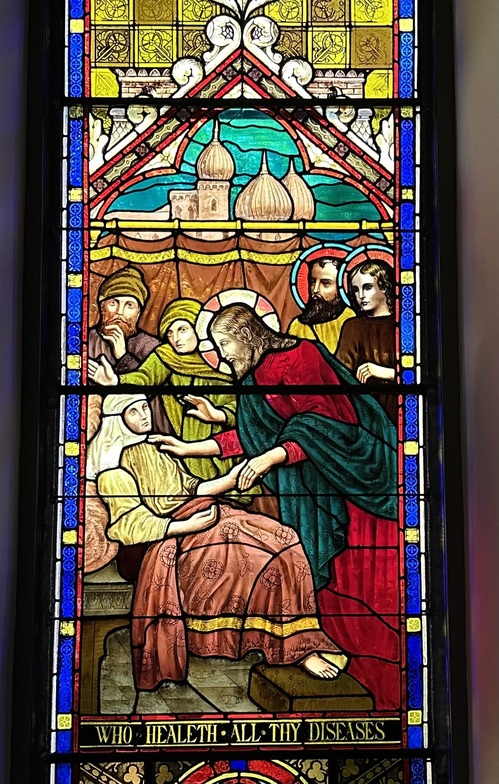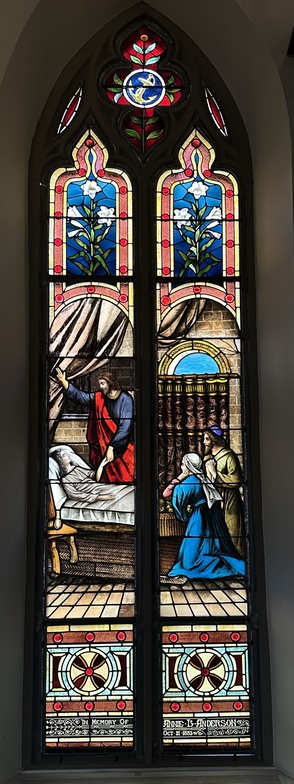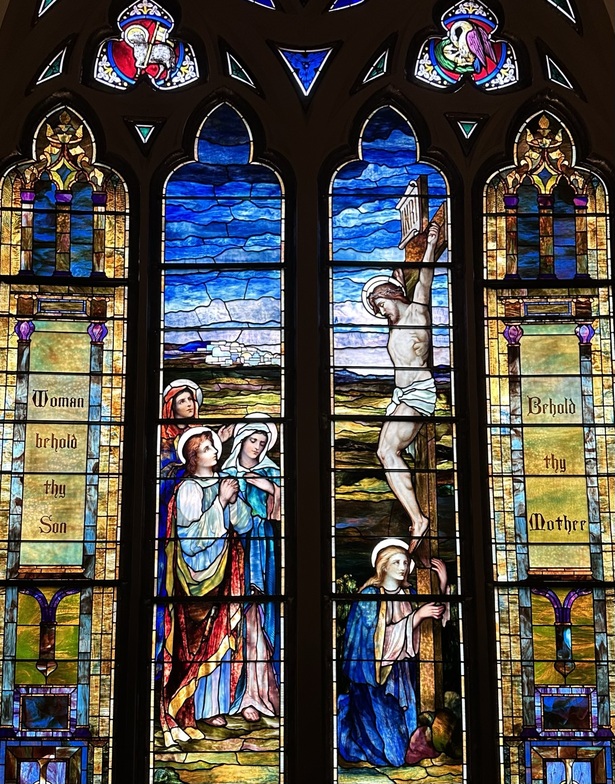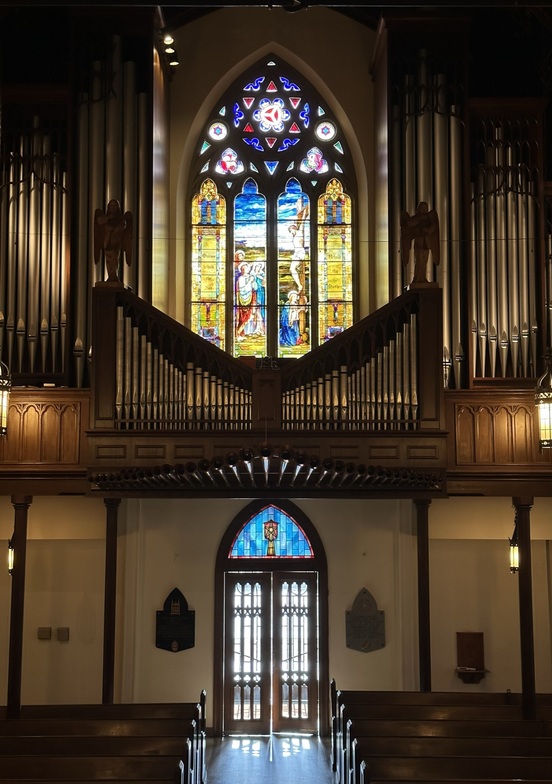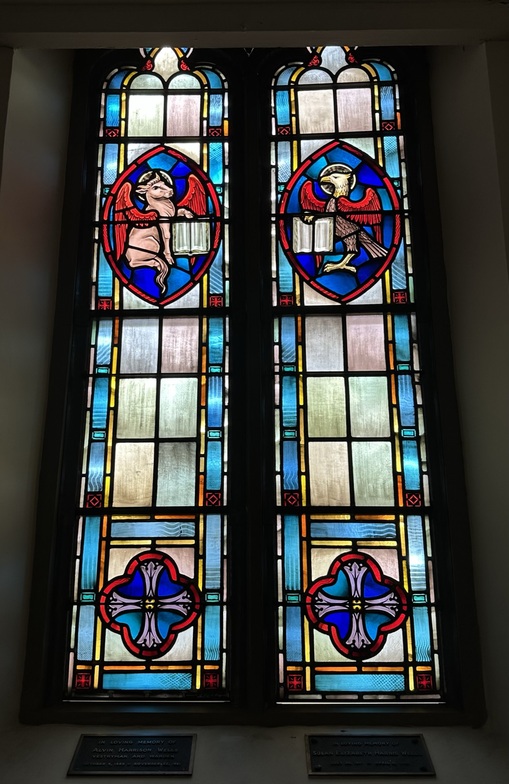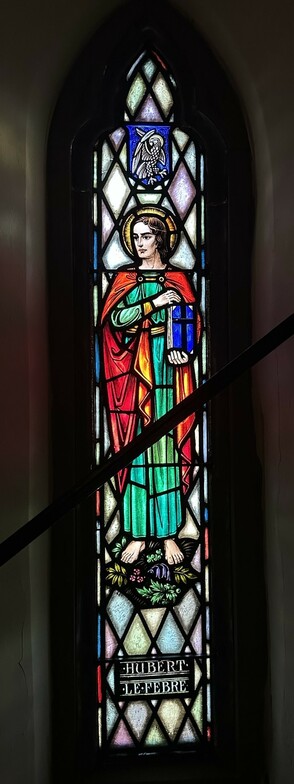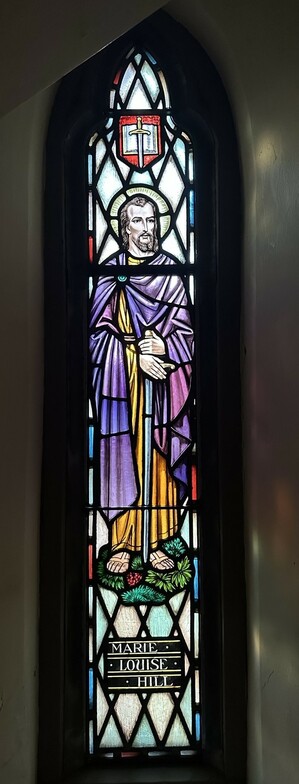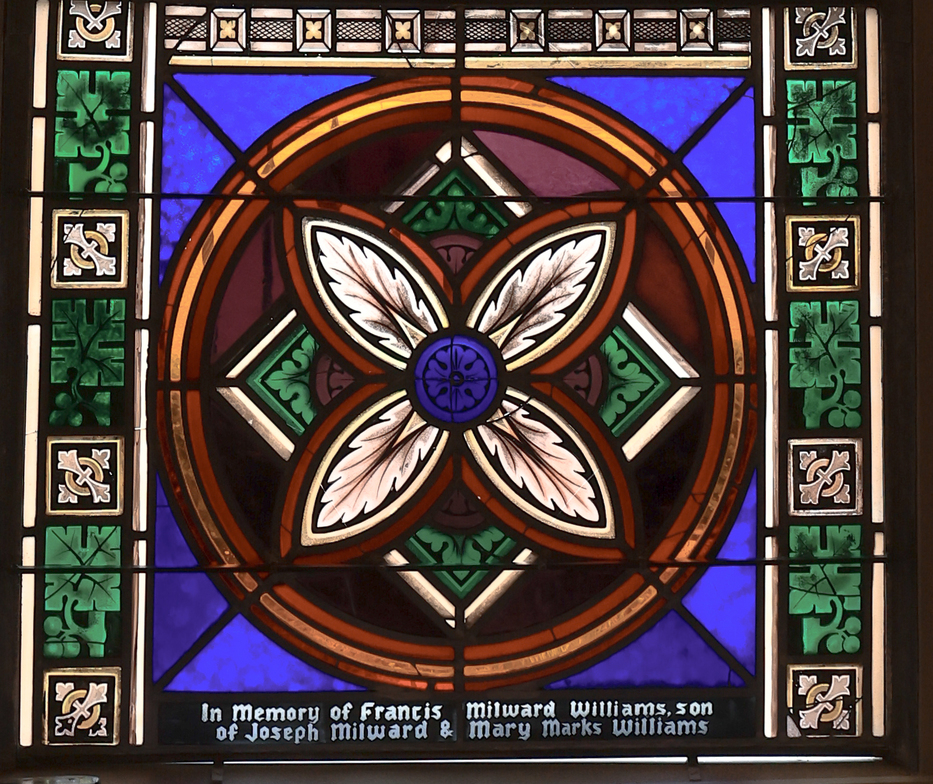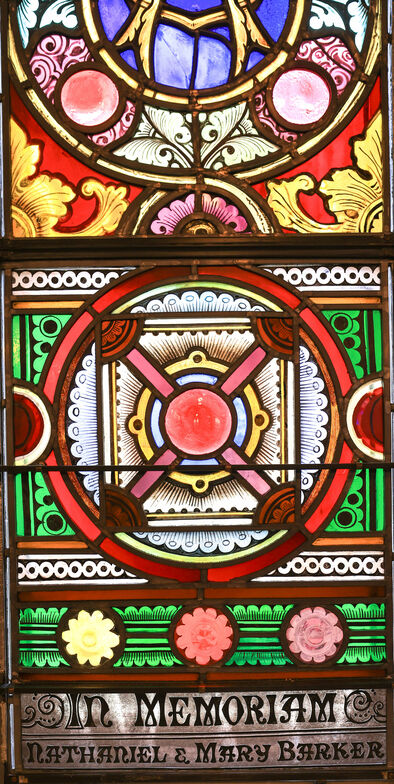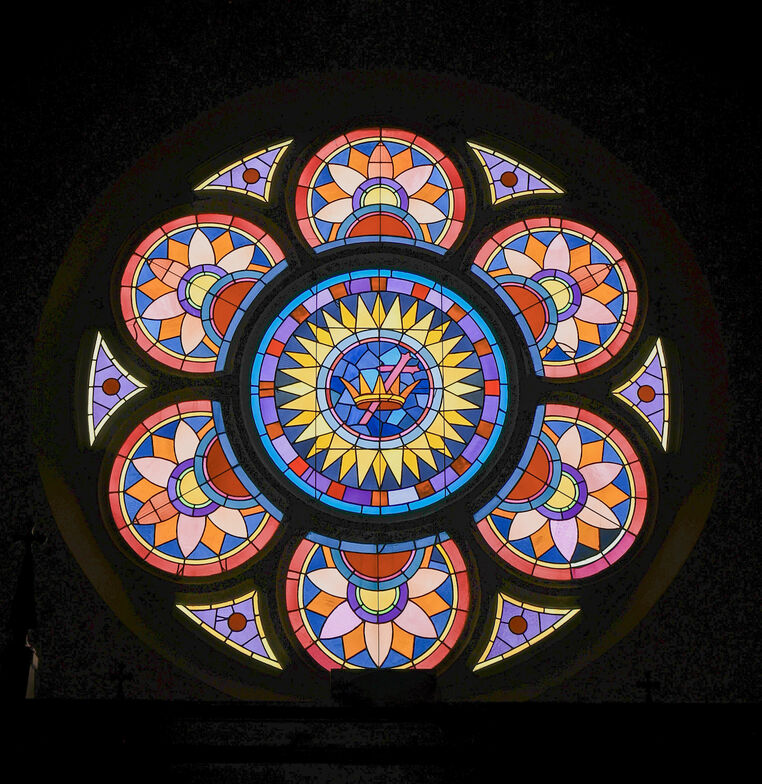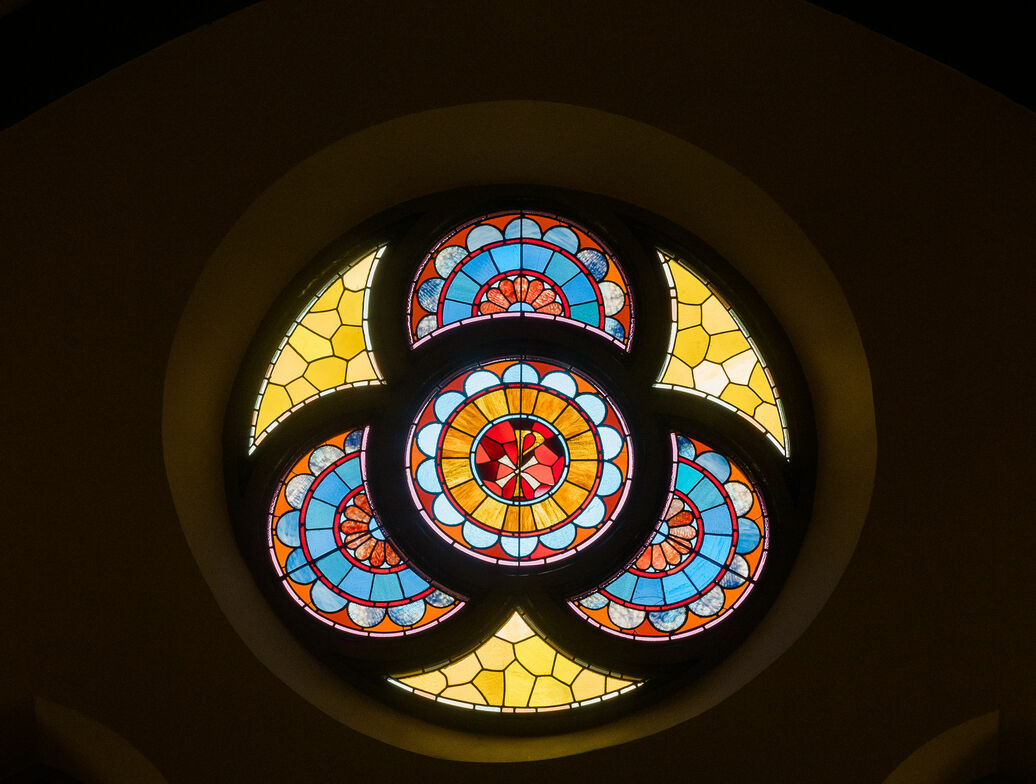Stained Glass of St. John's
St. John's Stained Glass Gallery
Scroll down to read about the heritage and history of the St. John's stained glass.
Sommerville-Noble Memorial (c. 1887)
The left panel of this window represents Faith. A woman holding a cross often symbolizes Faith in Christian art, a symbol reinforced here by the inscription, “Jesus saith have faith in God.” (Mark 11:22)
The woman might also be meant to represent Ann Sommerville, a founder of St. John’s in whose memory the panel was placed. As a young woman, Ann was part of a women’s sewing circle that, before 1834, formed the nucleus of Episcopal worship in Montgomery. Whenever an Episcopal priest visited town in those days, these ladies and other Episcopalians gathered for worship in the Sommerville home, and Communion was celebrated on a mahogany table in Ann’s living room. On December 20, 1833, she was among the group of “three gentlemen and three ladies” who met to organize the parish of St. John’s.
The right panel is a memorial to Ann Sommerville’s daughter, Martha Ann Noble, and to Martha Ann’s husband John Noble. It depicts a colorful scene from the Old Testament drama, Esther about to be crowned Queen. The inscription from the Book of Esther reads, “He set a Royal Crown upon her head.”
Restored in 2021 by Femenella & Associates, Branchburg, NJ
Morris Conley Memorial (1870s or early 1880s)
This window depicts Jesus’ memorable parable from Luke’s Gospel, showing the Samaritan assisting an injured traveler along the roadside. The inscription at the bottom of the window describes both the good Samaritan and Morris Conley, the man in whose memory the window was placed: “He went about doing good.” Conley died in 1861, a few months after the start of the Civil War.
Morris Jones Conley was the St. John’s vestryman who presented the resolution in 1852 to build a new church building. This “new building” is, of course, our current Nave, completed in 1855. He was also part of the committee tasked with securing plans for the new church.
Conley was active in diocesan and national church affairs from an early date, being elected a delegate to represent the Diocese of Alabama at every General Convention of the national Episcopal Church from 1838 until 1859. He was also an Alabama trustee for the General Theological Seminary in New York from 1844 to 1861.
This window had suffered a good bit of damage over its long life, most recently in 2000 when the traveler’s head, chest and arm were damaged due to vandalism. The broken section was partially repaired 20 years ago, but we recently discovered that some earlier repairs – perhaps from the 1930s or 1940s – had been poorly executed (in one case, with the wrong color glass). The current restoration returns the window, as closely as possible, to its original 19th century appearance.
Restored in 2021 by Femenella & Associates, Branchburg, NJ
Hall-Doughtie Memorial (c.1883-1885)
The scene portrayed in this double window is Jesus at Bethany in the home of Mary and Martha. As in the Gospel story, Mary, the spiritual sister, sits at Jesus’ feet receiving his blessing, while Martha, the more practical sister, stands in the background preparing to bring him sustenance. (Luke 10:38-42)
The window was given in memory of two sisters, both of them baptized, raised and married at St. John’s. Sarah James Farley Doughtie died in 1879 at age 25, and her sister Zoonomia Belle Farley Hall died three years later at age 30. Their parents probably chose the story of Mary and Martha as an appropriate subject for a joint memorial to two sisters.
This window is one of the earliest in St. John’s to contain opalescent stained glass (albeit in small amounts). Developed in the early 1880s by John LaFarge and Louis Comfort Tiffany, opalescent glass revolutionized the ancient art of stained-glass window making. Its milky opacity, created by the mixture of two or more colors and the suspension of particles that reflect and scatter light, creates a distinctive quality. Later windows by Tiffany and the Lamb Studio used opalescent glass to a much greater extent and to greater effect, as can be seen in St. John’s windows 8, 10 and 11.
Restored in 2022 by Femenella & Associates, Branchburg, NJ
Eliza J. Ball Memorial (1887)
Eliza Jane Pollard Ball was one of the earliest members of St. John’s Parish. Her husband, George Claiborne Ball, was a member of the Vestry in 1838 and 1839, and her brother Charles Teed Pollard was Senior Warden for 41 years (beginning in 1844). Her son, Charles Pollard Ball, married Ann Mary Seibels in 1868, and it is in their memory that the two large paintings on either side of the Nave were later given. Eliza was buried from St. John’s in 1870.
This exquisite window shows Jesus standing in front of the empty tomb on the Day of Resurrection. An angel holds the stone slab in the background while two dazed-looking guards are seated in the foreground.
The glass that forms Jesus’ robes is an unusual type of “ripple glass,” with an uneven surface on the exterior of the window. The effect is such that when the afternoon sun hits the windows directly, the robes sometimes seem to sparkle. In addition, Art Femenella notes the masterful use of “silver stain” in the halo around Jesus’ head. Silver stain is a technique first developed in the 14th century which involves the skillful application of silver nitrate and certain resins to the glass before kiln-firing (at about 1050° F) in order to produce shades of yellow, gold and amber in varying intensities.
Restored in 2022 by Femenella & Associates, Branchburg, NJ
John D. & Mary Ann Phelan Memorial (1882)
The two figures depicted in the lancets of this window have sometimes been interpreted as Jesus and Mary, but they more likely represent Faith and Hope. In Christian iconography, Faith is often depicted as a woman holding a cross (see, for example, window #1), and Hope as a woman holding an anchor.
The lancet panels were made by the J&R Lamb Studio of New York and were installed in March of 1882.
The stained-glass medallion in the upper part of the window is older than the rest of the glass. The medallion dates to the original construction of the Nave in 1855. Originally, all of the Nave windows were double windows featuring a medallion like this one at the top (and with the lancets probably glazed with plain leaded glass). In most cases, the medallions were replaced when the lower sections were “upgraded” to stained glass. But in this window and in two others (#14 and #16), the original medallion remains.
The window is a memorial to John D. and Mary Ann Phelan, given by eight of their twelve children. John Phelan was a state Supreme Court Justice and a prominent and respected layman in the Diocese of Alabama. After the Civil War, he moved to Sewanee, Tennessee and served as professor of law there until his death in 1879. Mary Ann Phelan died in 1870.
Eighteen years after this window was given, the last two living Phelan children would give the Ascension window (#10) over the altar.
Restored in 2022 by Femenella & Associates, Branchburg, NJ
Window 6 – “Guardian Angel”
Francis M. Williams Memorial (1870s or early 1880s)
This much-loved window is a memorial to a child who died in 1869, just one month before his third birthday. It has sometimes been called “The Angel of Death,” but most prefer to see it as “The Guardian Angel.” The child, Francis Milward Williams, was the son of Dr. Joseph M. Williams and Mary Louise Marks Williams.
As with most of the older glass in St. John’s, the maker of this window is unknown, but in this case we know that the imagery is based on a painting by German artist Wilhelm von Kaulbach. The window is made from painted and stained antique glass, and the starry sky is created by the acid-etching of flashed blue glass – cutting away the blue layer to reveal the clear glass underneath. The same unknown American studio that created this window probably also made the Good Shepherd window (#12), which has an identical border and upper medallion, and may have made two others (#2 and #15).
When originally installed, the window’s lower panel was modified to create a large vent that would tilt open. (Ventilators of this type were a feature of most windows in the days before air conditioning, but by the 1960s all of them had been sealed shut.) As part of the recent restoration, the vent’s metal frame and hardware were removed, allowing the window’s glass design to be viewed as originally intended. Repairs to the lower panel also included restoration of the memorial inscription, making it readable for the first time in decades.
Restored in 2022 by Femenella & Associates, Branchburg, NJ
Window 16 – “The Beatitudes”
Barker Memorial (probably 1870s)
This interesting window, with quotations from the Sermon on the Mount in its upper sections, is a memorial to Emma Langdon Barker, who died at age 3, and to her grandparents, Mary and Nathaniel Barker.
The left lancet shows a man and woman, both gazing heavenward, each equipped with a visible pair of wings. The faces appear to be quite specific, and may actually be portraits of Mary and Nathaniel Barker. Curiously, the glass artist has dressed the woman in ancient costume while the man wears a 19th century coat. The angel in the right lancet, with a star above its head, could be a portrait of little Emma. The Barkers were communicants of St. John’s as early as 1849.
The window is made of antique, mouth-blown glass. The three round flowers (or “jewels”) at the bottom of each lancet were created by plating a piece of colored glass with the foot of a wine glass, one of the many interesting features of this window. It is believed to be one of the oldest windows in the church.
As with windows 5 and 14, the original tracery medallion at the top, dating to 1855, was left in place when the window was installed in the 1870s.
Bell-Rutledge Memorial (1890)
This double window is a memorial to the Bell sisters, Sarah and Rebecca, who both died in 1889. It was the gift of their brother. (Window #13 on the opposite side of the Nave is an 1888 memorial to their father, A.R. Bell.) The left panel, the memorial to Sarah Bell, depicts a woman with children—a traditional representation of Charity in Christian art. Sarah was a St. John’s Sunday School teacher for 23 years before her death at age 39. The right panel is in memory of Sarah’s younger sister, Rebecca Bell Rutledge, who was married to Thomas Rutledge. It illustrates, fittingly, the Old Testament story of Rebecca at the Well. (Genesis Chapter 24)
The recent restoration included returning Charity and Rebecca to their proper positions in the window. For the past 70 years, Rebecca was on the left side and Charity on the right. But experts at Femenella & Associates were puzzled by this arrangement, observing that principles of stained-glass window design would more likely place Charity and Rebecca in opposite positions looking towards each other. After some research, we determined that the window was one of several removed for repairs in 1950 and that, when it was reinstalled, the lancet panels must have been put back in the wrong openings. Documentation from 1890 further establishes an original configuration of Charity on the left and Rebecca on the right.
In addition to the above correction, the name of Rebecca Rutledge, which had been absent from the window’s lower panel as a consequence of some damage many years ago, has now been restored.
Stringfellow Memorial (probably 1870 or 1871)
This double lancet is believed to be the oldest window in the church (apart from some older tracery glass). It likely dates to the time of the 1869–1870 church renovation, which included an extension to the Nave and adding a new Chancel.
Both figures in the window probably represent Christ, although the figure on the right could be John the Baptist. The lower sections depict a baptismal font and a chalice, representing Holy Baptism and Holy Eucharist, the two great sacraments given by Christ to his Church. (BCP, p. 858)
The lancets are memorials to Maggie and Louis Stringfellow, two young children of Mary Muir Stringfellow and the Rev. Horace Stringfellow. Maggie’s death, at age three, occurred just a few weeks after her father began his tenure as Rector of St. John’s. Louis had died three years earlier, probably in Indianapolis, where Dr. Stringfellow had served as rector before coming to Montgomery.
Horace Stringfellow was Rector from 1869 to 1893, and he was a man of remarkable energy, talent and taste. In addition to his duties as pastor and priest, he oversaw significant additions and improvements to the church property during his 24-year rectorship. These include all 14 of the stained-glass windows along the Nave walls; the stenciled ceiling designs (which he himself helped paint); the pulpit and lectern; the baptismal font; the bishop’s chair (made by him in his woodshop); the reredos; and the altar cross. He personally gave the altar as a memorial to his parents.
This window, the lovely gift of Dr. and Mrs. Stringfellow, was perhaps the first of the many memorials made during the Stringfellow era.
